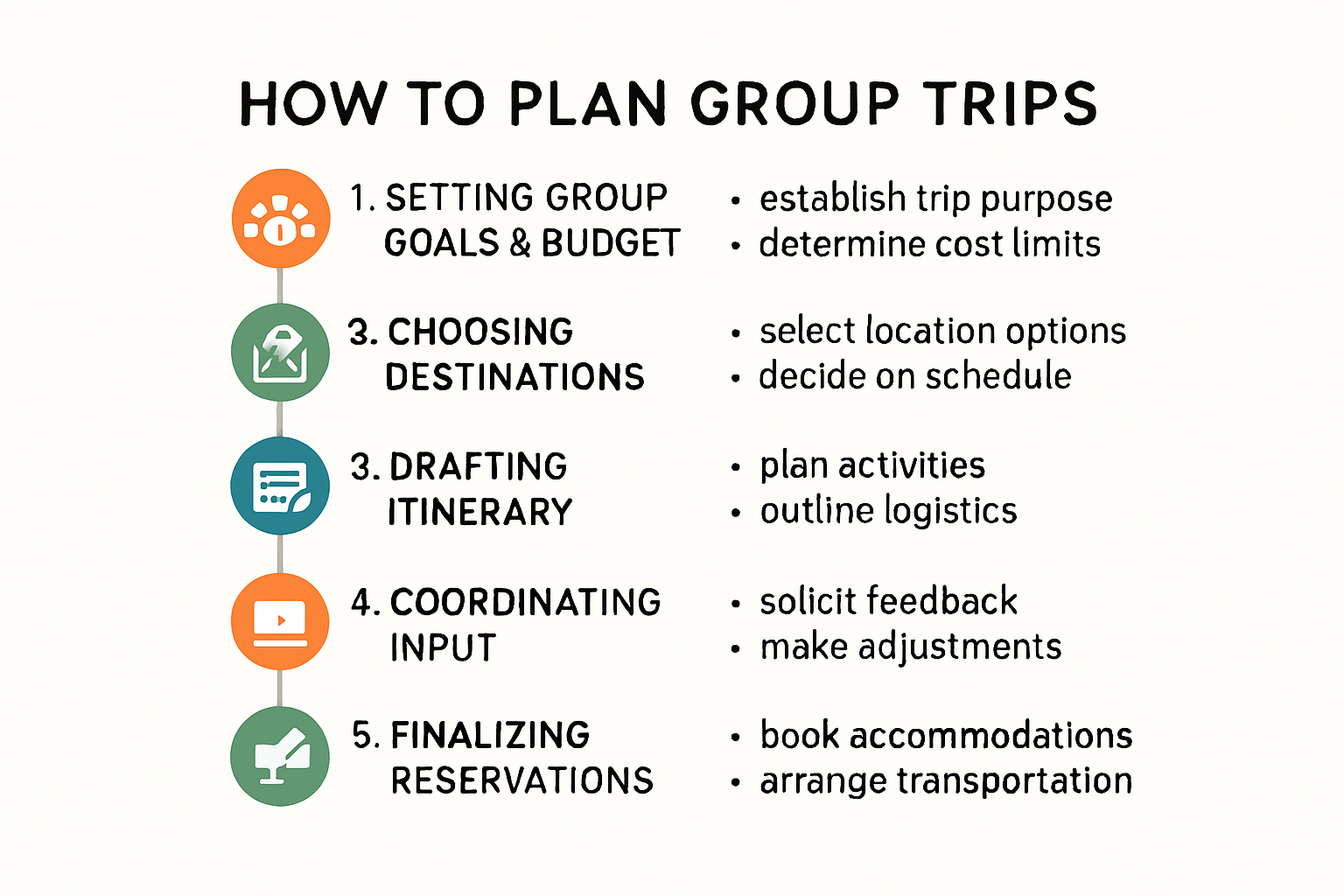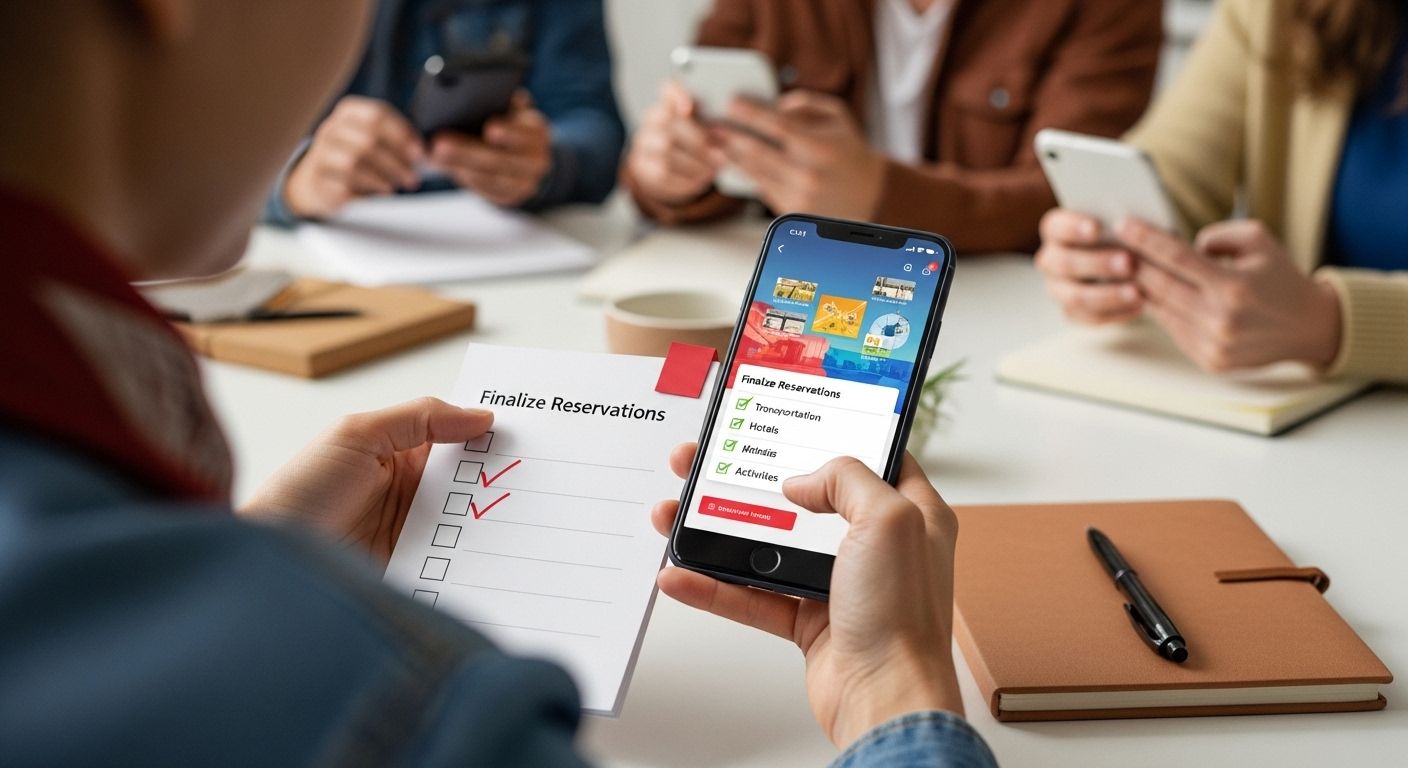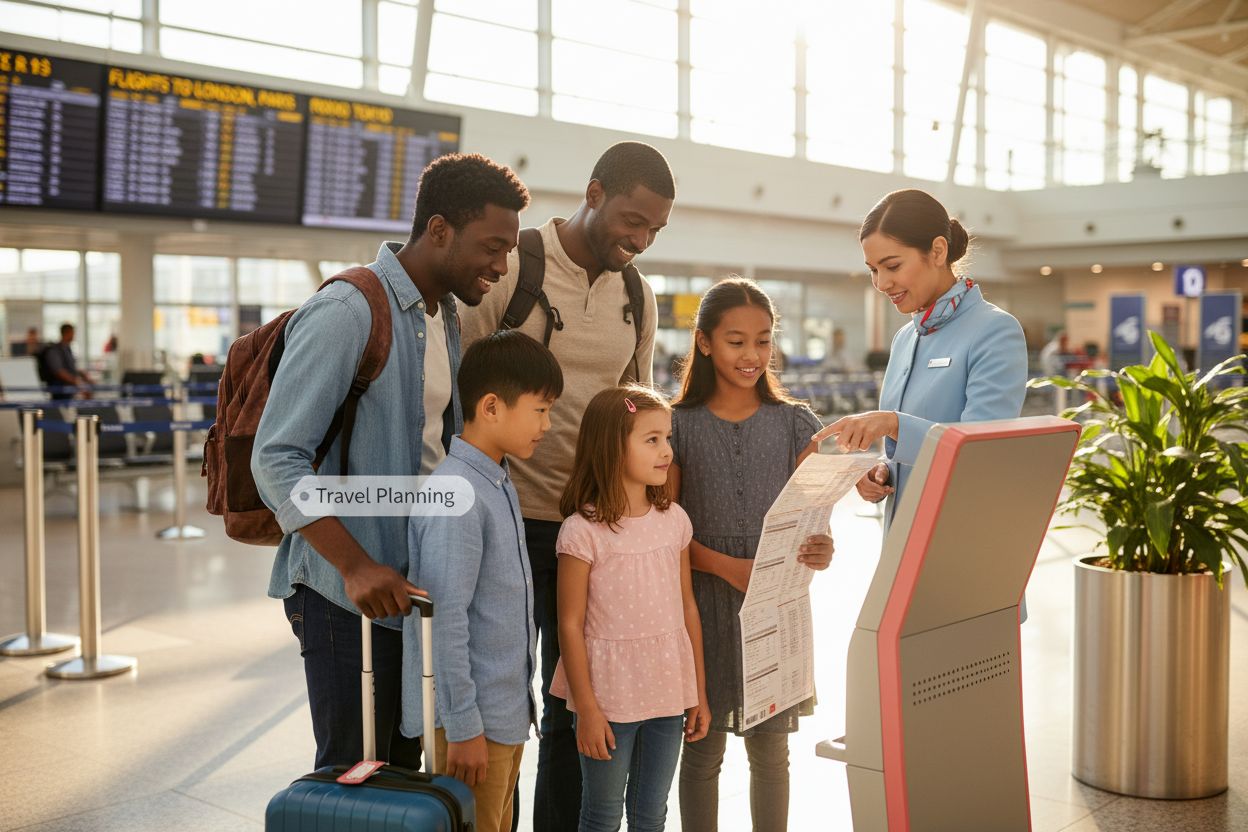Group travel promises unforgettable memories, vibrant stories, and stronger friendships. But according to Princeton University, group travel expenses can stack up quickly and often include hidden costs that surprise even the most experienced planners. Most people think planning a trip with friends or family is simple, but the real secret is that clear communication and upfront expectations make all the difference between chaos and adventure.
Table of Contents
- Step 1: Define Your Trip Goals And Budget
- Step 2: Select Your Destination And Dates
- Step 3: Create A Group Itinerary Draft
- Step 4: Coordinate With Participants For Input And Adjustments
- Step 5: Finalize Reservations And Transportation
- Step 6: Confirm Details And Communicate With The Group
Quick Summary
| Key Point | Explanation |
|---|---|
| 1. Establish trip goals and budget | Align on trip purpose and realistic financial limits to ensure everyone is on the same page before planning. |
| 2. Select destination collaboratively | Create an inclusive decision-making process for choosing destination and dates that accommodates everyone’s interests and practicalities. |
| 3. Draft a flexible group itinerary | Collect input from all members to create a well-organized schedule that considers everyone’s preferences and allows for spontaneous experiences. |
| 4. Communicate effectively throughout planning | Use centralized communication channels and regular updates to keep all participants informed and engaged in the planning process. |
| 5. Confirm details and responsibilities | Ensure all group members review key trip information and responsibilities to facilitate a smooth travel experience. |

Step 1: Define Your Trip Goals and Budget
Planning a successful group trip starts with crystal clear goals and a realistic budget. Before you dive into specific destinations or travel dates, your team needs to align on the core purpose and financial framework of the adventure. This foundational step determines everything that follows and sets the stage for an unforgettable shared experience.
Begin by hosting an open conversation with all potential travelers about their expectations and trip objectives. Some groups want cultural immersion, others seek adventure, and some simply want relaxation. Understanding everyone’s core motivations prevents potential conflicts and ensures the trip meets collective desires. Ask critical questions like: What experiences are most important? Are we prioritizing budget or bucket list moments? How much time can everyone realistically commit?
Financial planning requires brutal honesty and transparency. According to Princeton University’s Travel & Expense program, group travel expenses typically include:
- Flights and transportation
- Accommodations
- Meals and dining
- Activity and entry fees
- Emergency and miscellaneous expenses
Establish a clear budget range that accommodates the most financially constrained traveler while maintaining trip quality.
Below is a summary table of major group travel expenses to help you plan your budget transparently:
| Expense Category | Examples | Notes |
|---|---|---|
| Flights/Transportation | Airfare, trains, car rentals, ride-shares, buses | Group booking can offer discounts |
| Accommodations | Hotels, hostels, vacation rentals, group lodges | Consider room sharing to lower costs |
| Meals and Dining | Restaurants, groceries, group meals | Account for dietary needs and meal frequency |
| Activities/Entry Fees | Tours, excursions, museums, tickets | Prioritize by group interests and budget |
| Emergency/Miscellaneous | Travel insurance, medical, unexpected expenses | Set aside a contingency fund |
Create a shared spreadsheet where everyone can see anticipated costs and contribute input. Recommend each person allocate a maximum amount they can comfortably spend without financial strain. This approach prevents awkward conversations later and ensures everyone feels included. If budget disparities seem significant, consider adjusting destination choices or trip length to find a comfortable middle ground.
For large group trips, consider appointing a financial coordinator who can track expenses, collect payments, and provide regular budget updates. Their role helps maintain financial transparency and reduces potential misunderstandings. Learn more about crafting the perfect travel budget to refine your planning approach and set your group up for success.
Step 2: Select Your Destination and Dates
Selecting the perfect destination and travel dates transforms your group trip from a vague idea into an actionable plan. This critical step requires balancing individual preferences, practical constraints, and collective excitement. Group travel destinations demand careful consideration of multiple perspectives and logistical challenges.
Start by creating an open and inclusive decision making process. Host a group meeting or create a shared digital workspace where everyone can contribute destination suggestions. Encourage participants to share their dream locations, but also discuss practical considerations like travel time, budget compatibility, and seasonal factors. Some groups might prefer a relaxing beach destination, while others crave cultural exploration or outdoor adventures. The key is finding a location that offers something exciting for everyone.
According to the CDC’s travel guidelines, selecting destination and dates requires thorough research about health requirements, seasonal conditions, and potential travel restrictions. Consider factors like weather patterns, local events, peak tourist seasons, and potential travel advisories. Crowdsource research by having each group member investigate potential destinations and share their findings. Create a collaborative spreadsheet tracking important details like:
- Average temperatures
- Estimated travel costs
- Required travel documents
- Potential group activities
- Accessibility considerations
Date selection involves complex scheduling negotiations. Recommend using digital scheduling tools that allow group members to indicate their availability. Online platforms like Doodle or When2Meet can help identify overlapping free periods without endless email chains.
Consider factors like work schedules, family commitments, and potential holiday or peak season pricing. Some travelers might have more flexible schedules, so prioritize finding a timeframe that works for the majority. Be prepared to make compromises and remain flexible.
Once you’ve narrowed down potential destinations and dates, take a final group vote to confirm the selection. Explore our comprehensive travel planning resources to refine your destination selection strategy and ensure a smooth planning process.
Step 3: Create a Group Itinerary Draft
Crafting a comprehensive group itinerary transforms your travel dreams into a structured, actionable plan. This crucial step requires balancing individual preferences, practical logistics, and the collective group experience. A well-designed itinerary serves as the roadmap that keeps your group aligned and excited about upcoming adventures.
Begin the drafting process by gathering input from all travelers. Host a collaborative brainstorming session where everyone can share must-do activities and personal interests. Create a shared digital document or use collaborative planning tools that allow real-time editing and commenting. Prioritize activities that offer something for everyone, ensuring no one feels left out or overwhelmed. Consider the group’s physical capabilities, interests, and energy levels when mapping out daily experiences.
Structure your draft itinerary with realistic time allocations and built-in flexibility. Group travel requires more nuanced planning than solo trips, so include buffer times between activities and allow for spontaneous experiences. Map out core activities first, then fill in additional experiences around them. Consider factors like travel time between locations, potential rest periods, and individual preferences for free exploration. Some travelers might want structured group activities, while others prefer occasional solo adventures.
Practical considerations are crucial when drafting your group itinerary. Include critical details for each planned activity:
- Estimated duration
- Transportation requirements
- Potential costs
- Physical difficulty level
- Backup options in case of unexpected changes
Transparency and communication are key to successful group travel planning. Share the draft itinerary with all travelers and create a system for gathering feedback. Be open to modifications and willing to compromise. Some group members might have specific accessibility needs or personal constraints that require thoughtful adjustments. Discover expert tips for creating seamless travel plans to refine your group itinerary strategy.
Finalize the draft by conducting a group review session. Discuss potential challenges, confirm everyone’s comfort level, and make final adjustments. A successful group itinerary balances structured planning with the excitement of shared discovery.
Step 4: Coordinate with Participants for Input and Adjustments
Coordinating with group trip participants transforms a draft itinerary into a collaborative masterpiece that reflects everyone’s desires and constraints. This critical step requires careful communication, active listening, and diplomatic negotiation skills. Successful group travel hinges on making every participant feel heard and valued throughout the planning process.
Initiate a comprehensive feedback round by sharing the draft itinerary through a centralized communication platform. Digital tools like shared Google Docs, group messaging apps, or collaborative planning platforms can streamline this process. Create a structured feedback template that guides participants to provide specific, constructive input. Encourage travelers to highlight not just potential issues, but also exciting opportunities they see in the current plan. Be transparent about the constraints and trade-offs inherent in group travel planning.
According to research on group decision making, the coordination process is more complex than simply collecting opinions. Research from group dynamics studies suggests that group size and relationship strength significantly impact planning interactions. Address potential conflicts proactively by establishing clear communication guidelines and creating a fair mechanism for resolving differences.
Provide participants with a structured method for suggesting adjustments:
- Specific activity modifications
- Alternative destination suggestions
- Time allocation preferences
- Budget considerations
- Personal limitation disclosures
Approach each suggestion with openness and creativity. Not every proposed change can be implemented, but acknowledging each input demonstrates respect for individual perspectives. Schedule a group video call or in-person meeting to discuss complex adjustments that cannot be resolved through written communication. During this meeting, focus on finding compromise solutions that balance individual needs with overall group objectives.
Explore advanced group travel planning strategies to refine your coordination approach. The goal is creating an itinerary that generates collective excitement and ensures everyone feels invested in the upcoming adventure. Conclude the coordination phase by presenting a revised itinerary that incorporates feasible suggestions and clearly explains why certain recommendations could not be fully implemented.
Step 5: Finalize Reservations and Transportation
Finalizing reservations and transportation transforms your group trip from a theoretical plan into a concrete reality. This critical stage requires meticulous attention to detail, strategic coordination, and proactive problem solving. Group travel logistics demand precision and careful consideration of multiple moving parts.
Begin by creating a comprehensive reservation tracking system. Develop a shared digital spreadsheet where every participant can view and verify their individual bookings. Assign a designated point person responsible for coordinating group reservations and tracking critical deadlines. This approach ensures accountability and prevents miscommunication. Prioritize group bookings that offer flexibility and potential discounts for multiple travelers.
According to Princeton University’s group travel guidelines, groups traveling with 10 or more individuals can leverage special booking options. Contact airlines, hotels, and transportation services directly to negotiate group rates and explore package deals. Many providers offer advantages like holding seats without immediate traveler names and providing more flexible payment schedules.
Essential reservation and transportation considerations include:
- Consistent departure and arrival times
- Accommodation room configurations
- Shared transportation options
- Backup plans for potential travel disruptions
- Individual traveler documentation requirements
Communicate reservation details transparently and repeatedly. Send multiple confirmation emails, create group chat channels, and establish a system for real-time updates. Consider potential challenges like different arrival times, varying transportation needs, and individual traveler constraints. Some group members might require special accommodations or have unique travel requirements.
Explore comprehensive travel planning strategies to refine your reservation approach. Conduct a final group verification meeting where everyone confirms their individual bookings and understands the collective travel plan. Recommend that each traveler creates a personal digital and physical copy of their reservation documents. A successful reservation process creates a solid foundation for an incredible shared adventure.

Step 6: Confirm Details and Communicate with the Group
Confirming details and maintaining clear communication is the critical bridge between planning and executing a successful group trip. This step transforms your carefully crafted itinerary into a shared understanding that keeps every participant informed, aligned, and excited. Effective communication is the cornerstone of a smooth group travel experience.
Establish a centralized communication platform that works for all group members. Choose a digital tool that accommodates different communication preferences and technological comfort levels. Group messaging apps, shared document platforms, or dedicated travel planning applications can serve as your primary communication hub. Create multiple communication channels to ensure no participant feels left out or overwhelmed. Some travelers might prefer email updates, while others thrive on real-time group chat interactions.
According to research on organizational communication, successful group coordination requires a structured yet flexible approach. Schedule regular check-in meetings or virtual updates where participants can ask questions, share concerns, and receive real-time information. These communication touchpoints build collective excitement and address potential anxieties before they become significant issues.
Key communication elements to confirm include:
- Final itinerary details
- Individual traveler responsibilities
- Emergency contact information
- Packing and preparation guidelines
- Contingency plans
Develop a comprehensive information packet that can be easily shared and referenced. This document should include all critical trip details, from flight numbers and accommodation addresses to group activity schedules and personal preparation recommendations.
Here is a checklist table to help you verify all essential communication items before departure:
| Item | Purpose | How to Distribute |
|---|---|---|
| Final itinerary details | Ensure everyone knows the trip schedule | Info packet & group chat/email |
| Individual responsibilities | Clarify roles for smooth coordination | Info packet & meeting |
| Emergency contact information | Facilitate quick response in case of issues | Info packet |
| Packing and preparation guidelines | Help travelers prepare properly | Info packet & reminder messages |
| Contingency plans | Prepare group for changes or emergencies | Info packet & group chat |
Encourage group members to review the packet thoroughly and ask clarifying questions well in advance of the departure date.
Explore advanced group communication strategies to refine your approach. Create a culture of open communication where participants feel comfortable expressing concerns or suggesting last-minute adjustments. The final communication review should leave every traveler feeling informed, prepared, and genuinely excited about the upcoming shared adventure. A well-communicated plan transforms group travel from a potential logistical challenge into an opportunity for collective joy and connection.
Ready to Organize a Truly Stress-Free Group Trip?
Group travel planning often means juggling endless spreadsheets, clashing calendars, and last-minute surprises that take the fun out of your adventure. If you have ever felt overwhelmed by the details or struggled to keep everyone informed, you are not alone. The article defined the importance of aligning goals, involving your whole group in itinerary planning, and coordinating every reservation and schedule. These steps make your trip unforgettable, but they can also create anxiety and confusion when managed without the right tools.

This is where Yopki changes everything. Our all-in-one web app eliminates spreadsheet chaos and puts your group on the same page in minutes. Instantly build smart itineraries that match your goals, let everyone provide input seamlessly, and keep all your travel details in one visual hub. You access a personalized AI Travel Concierge and our team can handle all your bookings when you want support. Do not let complicated group logistics steal your excitement. Visit Yopki’s homepage now and see how easy it is to transform your group plans into perfectly organized trips. Want even more tips for smooth travel? Check out our guide to creating seamless travel plans and make your next adventure unforgettable!
Frequently Asked Questions
How can I effectively define trip goals for my group?
To effectively define trip goals, host an open conversation with all potential travelers to discuss their expectations and desires. Ask critical questions about their priorities, such as cultural immersion, adventure, relaxation, and budget constraints. This ensures everyone feels included and on the same page.
What should I consider when selecting a destination for a group trip?
When selecting a destination, balance individual preferences with practical constraints. Consider factors like travel time, budget compatibility, health requirements, weather conditions, and local events. Create a collaborative workspace for group members to share their dream locations and research findings.
How do I create a comprehensive group itinerary?
To create a comprehensive itinerary, gather input from all participants on must-do activities. Structure the itinerary with realistic time allocations, including buffer times for spontaneity. Ensure that the plan includes critical details for each activity and allows flexibility for unplanned experiences.
What are key elements to communicate before the trip?
Key elements to confirm include final itinerary details, individual traveler responsibilities, emergency contact information, and packing guidelines. Create a comprehensive information packet for easy reference to ensure all participants are well-informed and prepared before departure.



